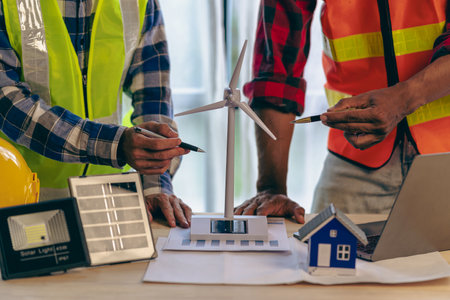1. Understanding the Unique Challenges of Older UK Homes
Traditional British housing stock, ranging from charming Victorian terraces to solid pre-war semis and classic Georgian townhouses, forms a defining feature of the UK’s built environment. While these properties offer character and a sense of history, they also present unique challenges when it comes to upgrading for modern energy efficiency. Many older homes were constructed with solid brick or stone walls, single-glazed sash windows, and little to no insulation. Draughty doors, ageing roofing materials, and outdated heating systems are common. These characteristics make them particularly prone to heat loss and inefficient energy use, especially compared to newer builds that meet stricter building regulations.
Retrofitting such properties isn’t as straightforward as simply installing new technology. The age and construction methods mean there may be hidden issues like damp or structural weaknesses to address first. Additionally, many older homes are listed or located within conservation areas, which brings strict planning restrictions that limit what can be changed externally or even internally. Balancing respect for heritage features with the need for improved comfort and lower energy bills requires careful planning and specialist knowledge. Homeowners must consider both the technical constraints of older buildings and the importance of maintaining their historical value while embracing smart energy solutions.
2. Evaluating Energy Performance and Identifying Priorities
Before investing in any retrofitting measures, it’s essential to understand how your older UK property currently performs in terms of energy use. This not only helps you target improvements effectively but also ensures that you get the best return on investment while increasing comfort and safety.
Assessing Current Energy Efficiency
The first step is to obtain an Energy Performance Certificate (EPC), which provides a standardised assessment of your homes energy efficiency. In the UK, EPCs rate properties from A (most efficient) to G (least efficient) and include recommendations for improvement. If your home doesn’t have a recent EPC, arranging one through an accredited assessor is straightforward and often required when selling or renting out a property.
Home Surveys and Inspections
Alongside EPCs, a detailed home energy survey by a qualified professional can identify hidden issues such as draughts, outdated insulation, inefficient heating systems, or single-glazed windows. These surveys may involve thermal imaging and air tightness tests, offering valuable insights into where heat is being lost and which upgrades would be most impactful.
Determining Priority Areas for Retrofitting
Not every upgrade will deliver the same benefits. To make informed decisions, consider factors like cost-effectiveness, disruption to daily life, local climate conditions, and any planning restrictions common in historic UK homes. The table below outlines typical retrofit priorities for older properties:
| Area | Common Issues | Potential Retrofit Solutions | Expected Benefits |
|---|---|---|---|
| Walls | Poor insulation, damp ingress | Cavity wall/solid wall insulation | Reduced heat loss, lower bills |
| Windows & Doors | Draughts, single glazing | Draught-proofing, double/triple glazing | Improved comfort, noise reduction |
| Heating Systems | Inefficient boilers/radiators | Smart thermostats, modern boilers or heat pumps | Lower running costs, better control |
| Roofs & Lofts | Lack of insulation | Loft insulation/top-up existing insulation | Prevents heat escaping upwards |
| Lighting & Appliances | Inefficient bulbs/appliances | LED lighting, smart plugs/devices | Lower electricity usage |
Your Next Steps: Setting Retrofit Goals
After gathering information from EPCs and surveys, prioritise the areas with the highest potential savings or comfort improvements. Consider both quick wins—like draught-proofing—and longer-term investments such as upgrading heating systems or installing smart controls. This targeted approach ensures that retrofitting efforts are both practical and tailored to the unique character of older UK homes.

3. Smart Energy Solutions Suitable for Heritage Properties
When retrofitting older UK properties, especially listed or heritage homes, it’s crucial to balance modern energy efficiency with the preservation of original features. Fortunately, several smart technologies are designed to be minimally invasive, ensuring your period property retains its character while benefiting from 21st-century comfort and efficiency.
Programmable Thermostats and Zoning Controls
Modern programmable thermostats, such as smart heating controls from brands like Hive or Nest, allow homeowners to set precise schedules and remotely manage temperatures room by room. These systems often connect wirelessly to existing boilers, requiring minimal installation and wiring, which is ideal for properties where you want to avoid damage to historic plasterwork or wood panelling.
Intelligent Lighting Solutions
Smart lighting, including LED bulbs and wireless switches, offers a flexible way to improve energy use in older homes. With options such as dimmable bulbs and app-based control, you can tailor lighting to suit daily routines and moods without disturbing delicate ceiling roses or ornate cornicing. Wireless smart switches mean no need for chasing cables into walls, preserving your home’s historic details.
Discreet Renewable Systems
Integrating renewable energy solutions doesn’t have to mean altering your home’s exterior. Air source heat pumps designed for quiet operation can often be placed discreetly in gardens or behind outbuildings. Solar panels can sometimes be installed on less-visible roof pitches or outbuildings, subject to planning permission. Battery storage systems are compact enough to fit inside utility rooms or under stairs, making them suitable even for homes with limited space.
Preserving Character While Upgrading Efficiency
The key with heritage properties is a sensitive approach—choosing technologies that respect the building’s history while delivering tangible savings on energy bills. Working with specialists familiar with conservation requirements ensures compliance with local council guidelines and helps maintain your property’s unique charm.
4. Navigating UK Regulations and Planning Permissions
When retrofitting older UK properties with smart energy solutions, it’s essential to ensure your project aligns with local regulations and planning requirements. Many period homes—particularly those in conservation areas or listed as Grade I, II*, or II—require specific permissions before you can install modern technologies such as solar panels, heat pumps, or external wall insulation.
Understanding Building Regulations
Building regulations in the UK are designed to ensure that any upgrades maintain the safety, structural integrity, and energy efficiency of your property. Upgrading insulation, fitting new heating systems, or altering windows and doors must meet standards outlined in Approved Documents Part L (Conservation of Fuel and Power) and Part F (Ventilation). Before starting any works, consult your local authority building control team or a certified installer for guidance on compliance.
Permissions for Listed Buildings and Conservation Areas
If your property is listed or located in a conservation area, you’ll need Listed Building Consent or planning permission for most retrofit measures. This applies to visible installations such as solar panels, double glazing, and external wall insulation. Failure to obtain these consents can result in legal action or having to remove the improvements at your own expense.
Typical Retrofit Measures Requiring Permission
| Retrofit Measure | Listed Buildings | Conservation Areas |
|---|---|---|
| Solar Panels | Usually required | Often required if visible from street |
| External Wall Insulation | Required | Required if altering appearance |
| Double/Secondary Glazing | Required | Sometimes required |
| Heat Pumps (external) | Required | Sometimes required |
| Draught-proofing/Insulation (internal) | Often not needed but check details | Not usually needed unless affecting facade |
Top Tips for Securing Permissions
- Liaise Early: Speak with your local planning authority before making decisions.
- Document Changes: Prepare detailed plans and heritage statements showing how your retrofit respects the building’s character.
- Work with Specialists: Use contractors experienced in historic building retrofits—they understand the balance between energy efficiency and heritage preservation.
- Select Discreet Solutions: Opt for technologies that minimise visual impact where possible (e.g., solar slates instead of panels).
- Follow Up: Keep records of all permissions granted for future reference or resale.
Navigating these rules can seem daunting, but careful preparation ensures your smart energy upgrades are both lawful and sympathetic to your home’s unique history.
5. Costing, Grants, and Funding Options
One of the most significant considerations for homeowners looking to retrofit older UK properties with smart energy solutions is the financial aspect. While energy-efficient upgrades can ultimately lead to long-term savings on utility bills, the upfront costs can be substantial, especially when dealing with heritage or period homes that may require specialist work. Typical expenses might include insulation improvements, the installation of smart thermostats and meters, upgrading to double or triple glazing, and integrating renewable technologies such as solar panels or heat pumps. For a semi-detached Victorian house, for example, basic insulation and draught-proofing might start from a few hundred pounds, whereas comprehensive retrofitting with smart controls and renewable systems could run into several thousands.
Government Incentives
The UK government recognises the importance of making older housing stock more energy efficient and offers various incentives to ease the financial burden. The Boiler Upgrade Scheme (BUS) provides grants towards low-carbon heating systems like heat pumps. The Energy Company Obligation (ECO4) scheme requires major energy suppliers to fund energy-saving measures for eligible households, often at no cost or heavily subsidised rates. Additionally, local authorities sometimes offer council-led grant schemes targeted at low-income households or those living in fuel poverty.
Available Grants and Support
Grants are available from multiple sources beyond central government. Homeowners may benefit from regional Green Homes Grant Local Authority Delivery schemes or access support through organisations such as the Energy Saving Trust. These initiatives often prioritise vulnerable groups but can also apply to broader retrofit projects depending on funding cycles and local priorities.
Funding Your Retrofit Project
Many banks and building societies now offer “green mortgages” or home improvement loans designed specifically for energy efficiency works. These financial products may come with preferential rates if you commit to raising your property’s EPC (Energy Performance Certificate) rating. It’s wise to consult with a qualified retrofit coordinator or accredited installer before starting any work to ensure eligibility for grants and optimal use of funds.
In summary, while retrofitting older UK properties with smart energy solutions requires investment, a combination of careful planning, government incentives, and grant funding can make these projects much more accessible. By exploring all available options and seeking professional advice, homeowners can improve comfort and efficiency without breaking the bank.
6. Ensuring Safety and Longevity through Professional Installation and Maintenance
When retrofitting older UK homes with smart energy solutions, safety and reliability must be top priorities. Engaging certified professionals for installation is essential to ensure all systems meet current British standards and regulations. A qualified installer will understand the quirks of period properties—from outdated wiring to unique construction materials—ensuring that your new tech integrates seamlessly and safely without compromising the building’s structure or heritage features.
Best Practices for Professional Retrofitting
Always begin with a thorough property assessment by a trusted electrician or energy consultant familiar with older UK buildings. This helps identify potential hazards such as old fuse boxes or ungrounded circuits before any work begins. During installation, professionals should use high-quality, compatible components and follow manufacturer guidelines to the letter, reducing the risk of faults and maximising system lifespan.
Regular Maintenance: Keeping Systems in Top Shape
Once installed, regular maintenance is vital for both efficiency and peace of mind. Schedule annual inspections for all smart devices, boilers, heat pumps, and solar panels. This ensures early detection of wear or malfunction, preventing small issues from escalating into costly repairs. Many manufacturers offer service packages—these are well worth considering for hassle-free upkeep.
Tips for Ensuring Safety and Preserving Property Value
– Keep records of all installations, upgrades, and professional checks—this documentation is invaluable for future buyers and insurance purposes.
– Choose solutions designed with UK homes in mind; this means checking compatibility with local electrical systems and traditional building materials.
– Don’t be tempted by DIY shortcuts. Even if you’re handy around the house, smart energy systems involve complex integrations that demand specialist knowledge.
– Ensure that any retrofits don’t damage original features like mouldings or sash windows. Reversible installations help maintain your property’s character—and its value.
– Stay informed about new regulations and available grants; these can help you make the most of your investment while keeping your home safe and efficient.
By following these best practices, you’ll ensure that your upgraded property remains secure, sustainable, and attractive for years to come—all while honouring the charm of Britain’s beloved older homes.

